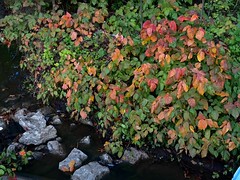November 19, 2010
As noted in the summary of my personal computers, I bought my first laptop computer back in 1997. I’ve bought three laptops since then, including a new MacBook Air which arrived yesterday. I brought them together for a side-by-side comparison.
The Averatec had a full-size keyboard and sluggish trackpad, the Asus had a slightly-reduced keyboard and small but responsive trackpad, while the MacBook Air has a full-size keyboard and big glass trackpad which is very responsive and supports multi-touch gestures. But I miss the dedicated right-click buttons of Windows machines and am not at all used to the current application’s menu bar being at the top of the screen instead of the top of its own window.
I accessorized the MacBook Air with an external SuperDrive DVD +/- burner and VGA-to-Display Port adapter. A carrying bag is on order from WaterField Designs as well as a Full Install DVD for Windows 7 Home Premium so I can run my Windows applications on it along with native OS X apps.
| 2005Averatec 3270 EE-1(PADD) | 2008Asus Eee PC 1000H (PADDe) | 2010MacBook Air 11” (Droxine) | |
| Native Operating System |
Windows XP Home, Service Pack 3 |
Windows XP Home, upgraded to Windows 7 Home Premium | Mac OS 10.6.5 (Snow Leopard) |
| Microprocessor | 1.6 GHzMobile Athlon Sempron 2800+ | 1.6 GHzIntel Atom n270 | 1.6 GHzIntel Core 2 Duo |
| Random-Access Memory | 480 MB | 2 GB | 4 GB |
| Disks | 60 GB hard drive, DVD +/- burner |
160 GB hard drive | 128 GB flash drive, separate DVD +/- burner |
| Weight Without Accessories | 4.5 pounds | 3.2 pounds | 2.3 pounds |
| Screen | 12.1 inch, 1024×768 | 10.2 inch, 1024×600 | 11.6 inch, 1366×768 |
| Battery Life | about 1.5 hours | 3-4 hours | about 5 hours |
| Connectivity | 3 USB, PCMCIA II, SD card, microphone, headphone, ethernet, modem, VGA, 802.11 b/g (built-in speakers) | 3 USB, SD card, microphone, headphone, ethernet, VGA, 802.11 b/g/n (built-in speakers and 1.3 megapixel camera) | 2 USB, headphone, Mini DisplayPort, 802.11 b/g/n, Bluetooth 2.1+EDR (built-in microphone, speakers, and camera) |
| My Cost Without Accessories / Today’s Resale Value at gazelle.com | $890 / none | $464 / $85 | $1350 / $700 |
It is interesting how the microprocessor speed has maxed out, making additional computing cores, on-board cache memory, and better disk speed vital to improved performance. Over time the weight has dropped significantly and the screen and battery life have improved, but my new Mac’s improved specs carry a hefty price premium.
Below is what they look like when closed alongside their power adapters. The silver Averatec’s at the bottom extends 12 feet while the black Asus’ extends 11 feet. I like how the MacBook Air’s power adapter has a retractable two-prong plug that goes directly to the wall for a reach of 6 feet, or you can swap that two-prong plug for a three-prong extension cord for a total reach of 12 feet. The other adapters have detachable cords, but no direct plug-in option.
Below you see how thick they are, and why I find the slimness of the new MacBook Air quite stunning.
As for approximate boot times, below is how they stack up with their existing operating systems. Soon I’ll update this with times for the Mac when booting into Windows 7 Home Premium.
| 2005Averatec 3270 EE-1(PADD) | 2008Asus Eee PC 1000H (PADDe) | 2010MacBook Air 11” (Droxine) | |
| Time from boot to login screen | 80 s | 46 s | 13 s |
| Time from boot to responsive desktop screen | 102 s | 65 s | 17 s |
| Time to boot from hibernation to responsive desktop screen | 58 s | 26 s | 1.5 s |
The solid state flash drive in the MacBook Air really makes it boot up quickly, while the sluggish hard drive in the old Averatec is a huge performance bottleneck at all times.
I’ve never owned an Apple Macintosh computer before, so I’ll have more to report on the MacBook Air as I learn more about its operating system, experiment with native software, and get Windows 7 on it via Boot Camp and/or a virtual machine.
Here’s a shot of my current portable devices side-by-side: the Apple iPhone 4, Amazon Kindle 3, Apple iPad, and Apple MacBook Air.
For my parting shot I set the iPad and iPhone atop the MacBook Air to show how that laptop is the same width as the iPad and the same length as the iPad alongside the iPhone 4.












Hi, Mr. Meador! Aside from the slimness, the new Air seems very similar to the MacBook I’ve had since January of last year… you might be interested in the (rather irritable) pros & cons list I put together after I’d used it a few days: http://blueboathome.com/node/223
After using it for a year and a half, I’m used to the screen resolution and the flat keys and the lack of a numeric keypad; the one thing that still annoys me after all this time is that there’s only one control and only one fn key, way in the lower-left of the keyboard, so getting a forward-delete (fn-Delete) or paging up and down (fn-up and fun-down) requires two hands.
Enjoy the new toy!
Ben, I enjoyed reading your informative review. I’m so new to Macs that forward delete was baffling me. What did you decide to do about running Windows? Did you use Boot Camp, or Parallels, or other virtual machine software?
Forward delete is not a Mac thing — it’s what you get when you press the Delete key on a PC; it deletes the character in front of the cursor instead of the one behind it. Macs confuse the issue by mislabeling the Backspace key as Delete and having no Delete key… if you want a forward delete, you have to press fn-Delete.
I wound up buying VMWare Fusion because it would work with my Boot Camp partition, and I’ve been glad I did — I wind up booting off the Boot Camp partition at least as often as I use VMWare, so it’s good to have the option. But I hear Parallels is good, too.
Pingback: GPS-Enhanced Day Hikes « MEADOR.ORG